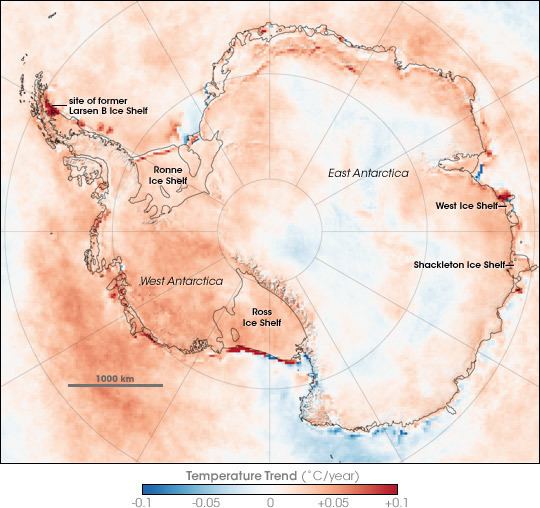 | ||
The effects of global warming in Antarctica may include rising temperatures and increasing snow melt.
Contents
Effects
The continent-wide average surface temperature trend of Antarctica is positive and significant at >0.05 °C/decade since 1957. The West Antarctic ice sheet has warmed by more than 0.1 °C/decade in the last 50 years, with most of the warming occuring in winter and spring. This is somewhat offset by cooling in East Antarctica during the fall. This effect is restricted to the 1980s and 1990s.
Research published in 2009 found that overall the continent had become warmer since the 1950s, a finding consistent with the influence of man-made climate change:
"We can't pin it down, but it certainly is consistent with the influence of greenhouse gases from fossil fuels", said NASA scientist Drew Shindell, another study co-author. Some of the effects also could be natural variability, he said.British Antarctic Survey
The British Antarctic Survey, which has undertaken the majority of Britain's scientific research in the area, has the following positions:
The area of strongest cooling appears at the South Pole, and the region of strongest warming lies along the Antarctic Peninsula. A possible explanation is that loss of UV-absorbing ozone may have cooled the stratosphere and strengthened the polar vortex, a pattern of spinning winds around the South Pole. The vortex acts like an atmospheric barrier, preventing warmer, coastal air from moving into the continent's interior. A stronger polar vortex might explain the cooling trend in the interior of Antarctica. [1]
In their latest study (September 20, 2007) NASA researchers have confirmed that Antarctic snow is melting farther inland from the coast over time, melting at higher altitudes than ever and increasingly melting on Antarctica's largest ice shelf.
There is also evidence for widespread glacier retreat around the Antarctic Peninsula.
Researchers reported December 21, 2012 in Nature Geoscience that from 1958 to 2010, the average temperature at the mile-high Byrd Station rose by 2.4 degrees Celsius, with warming fastest in its winter and spring. The spot which is in the heart of the West Antarctic Ice Sheet is one of the fastest-warming places on Earth.
